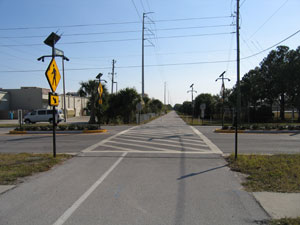

Assessing pedestrian and bicycle safety improvements in St. Petersburg

New bike lanes and trail crossings really are making a difference for pedestrians and bicyclists in St. Petersburg, Florida. This is the conclusion of a series of evaluations conducted by researchers at the UNC Highway Safety Research Center (HSRC). These evaluations were sponsored by the Florida Department of Transportation to assess new bicycle and pedestrian improvements across the state.
The City of St. Petersburg and its Neighborhood Transportation section have taken a variety of steps to increase bicycle and pedestrian safety in recent years. These steps follow adoption of the St. Petersburg CityTrails — Bicycle Pedestrian Master Plan in 2003. Improvements have included the installation of bike lanes, a green-colored bike lane weaving area, and upgrading of many uncontrolled pedestrian crosswalks throughout the city. Before these treatments can be more widely adopted, the effects on safety and driver, pedestrian, and bicyclist behavior need to be assessed.
One HSRC study looked specifically at green-colored pavement and signing that identifies a bicycle-motor vehicle weaving area, in which bicyclists continue straight through an intersection while motorists cross over the bike lane in order to make a right turn. The study found a significant increase in yielding behavior by motor vehicles, as intended by the treatment, leading to the conclusion that the green bike lane weaving area has operational and safety benefits for bicyclists in this particular case. It is recommended that additional study of colored bike lane weaving areas should be conducted in different traffic settings.
Another of the St. Petersburg studies examines the change in bicycle counts and speeds due to the installation of bike lanes. "It is assumed that installation of bicycle facilities will result in an increase in the number of bicyclists," explained William Hunter, senior research scientist at HSRC. "However, it is rare that any before and after counts are performed and reported in the literature."
The study of bicycle lanes focused on before-after analyses of two corridors in St. Petersburg. After bicycle lanes were introduced, the overall study showed an increase in bicyclists of 17 percent, though initial counts were quite low along the two specific corridors. Bicyclist average speeds showed no change. One of the conclusions from the study was that the addition of bicycle lanes alone on a street will not guarantee an immediate increase in bicycle volume. Other factors, including adjacent land use, convenient origins and destinations, and connectivity of a bicycle lane to other bicycle facilities within the street system are just as, or perhaps more critical, in terms of encouraging bicycling.
The third study examined the installation of a Rectangular Rapid Flash Beacon (RRFB) where a multi-use trail crosses a busy, four-lane, urban street. When the RRFB was installed, median islands were added to the site as well. In this case, trail users activate the RRFB by push button.
The study design gave researchers a unique chance to collect before and after video data of actual pedestrian and bicyclist trail users. Results of the study found that bicyclists and pedestrians reduced their crossing delay time, and that motorists yielded considerably more often, after the installation of the RRFB. Overall, motorist yielding increased from 2 percent before to 35 percent after.
However, observation indicates that yielding compliance by motorists would be much higher if trail users activated the RRFB more consistently. Thirty-two percent of the trail users pushed the button to activate the flashing beacons, 49 percent did not, and for 19 percent of the trail users the button had already been pushed. It was noticed that many bicyclists, who make up 82 percent of the trailís users, chose not to maneuver to push the button to activate the flasher. When supplemental data were collected at the scene by observers, they found that 80 percent of motorists yielded when the button was pushed.
The report recommends additional educational efforts to raise the percentage of trail users pushing the button to activate the signal, and to increase motoristsí knowledge about the requirement to yield at crossings. The researchers also suggest periodic police enforcement operations to increase yielding behavior. Incorporating automatic detection of trail users, which would obviate need to push a button, is currently being evaluated by the RRFB vendor.
In each of the cases studied for the City of St. Petersburg, research indicated increased safety for pedestrians and bicyclists, and the potential for gains in mode shift, that is people choosing to walk and bike rather than drive. However, the individual reports caution that none of the specific treatments are fail-safe strategies for reducing crashes and increasing walking and bicycle use. As indicated above, additional study of treatments, integrated planning of facilities, and increased education and enforcement are recommended to further these goals.
The University of North Carolina Highway Safety Research Center
730 Martin Luther King Jr. Blvd, Suite 300 | Campus
Box 3430 | Chapel Hill, NC 27599-3430
Phone: 919.962.2203 | Fax: 919.962.8710
http://www.hsrc.unc.edu